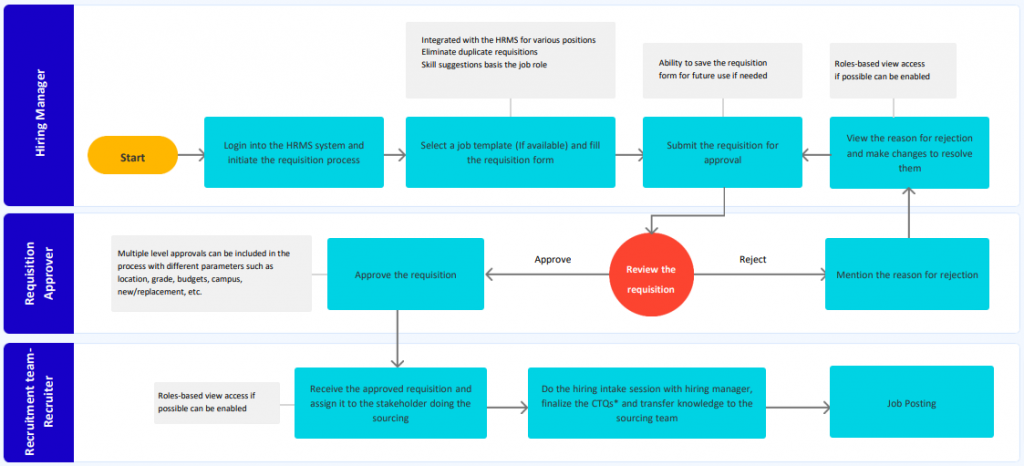An Introduction to Recruitment Process Flowchart
An organization’s existence is not defined by its walls but by the people within it. This direct correlation underscores the importance of strategic and intentional recruitment. Ensuring every new hire contributes to achieving organizational goals lays the stepping stone for lasting success. One misstep and businesses can lose as much as a trillion dollars per annum!
Enter a Recruitment Process Flowchart —a crucial tool in the ambitious endeavor of finding the perfect candidate.
A recruitment process flowchart is a visual representation of the different stages of an organization’s hiring process. Such as this one:

The flowchart gives a high-level view of the various stages of the recruitment process and how they flow into each other. Depicting the recruitment flow in a sequential and logical outline lends structure and cohesion to the larger objective of finding the right hire.
The Advantages of Recruitment Process Flowcharts
An end-to-end recruitment process flowchart promises the following advantages:
- Clarity and Comprehension: Since the hiring process flowchart illustrates the entire recruitment process, all internal and external stakeholders understand the various stages involved and their roles and responsibilities throughout.
- Process Enhancement: With the recruitment process flowchart granting visibility into the hiring process, organizations can identify and eliminate bottlenecks, redundancies, and inefficiencies plaguing recruitment.
- Effective Time Management: Seeing as how it takes six weeks on average to fill a position, recruitment process workflows eliminate delays caused by lengthy decision-making, task interdependencies, etc.
- Uniformity: The standardization offered by an end-to-end recruitment process flowchart ensures consistency in implementation, regardless of the position or business location, maintaining fairness and equity in hiring practices.
- Smoother Collaboration: The structure offered by recruitment process flowcharts fosters seamless collaboration between different departments and individuals involved in the hiring process, such as the HR department, hiring managers, interviewers, etc.
- Legal and Regulatory Compliance: A recruitment process flowchart is typically drafted while maintaining compliance with the prevailing legal and regulatory requirements for fair and non-discriminatory hiring practices.
- Continuous Improvement: A hiring process flowchart is a living document that keeps improving iteratively. It accounts for feedback loops that identify areas of improvement and refine recruitment with every cycle.
Crafting a Comprehensive Recruitment Process Flowchart
Now that the value proposition is clear, here is a step-by-step guide for developing a simple recruitment process flowchart:
1. Identifying Key Business Positions
Businesses may have an assorted blend of employees – some being a part of the workforce, some outsourced, some on a limited-time contract, and so on. So, start by identifying the key business positions for which you need to conduct recruitment.
While doing so, also seek out any talent or skill gaps by assessing current capabilities and matching them with business requirements. Taking a high-level stock of the skills and expertise available and required can make it simpler to develop an end-to-end recruitment process flowchart.
2. Developing Recruitment Stages
Once you understand who to recruit, you move on to how to recruit.
Chalk out the broader stages involved in a typical recruitment cycle. Here, you will define the crucial steps involved in the recruitment process – from listing the position on job boards to reviewing applications to interviewing potential candidates to final selection and onboarding. Capture the basic details of every stage, such as its primary objective, key stakeholders, recruitment technology, etc.
The stages don’t necessarily have to be in a defined order just as yet, and the key is to capture the core components.
3. Mapping Out the Process Outline
Now that the building blocks for a recruitment process are ready, you can commence outlining the recruitment process. This entails structuring the identified stages in logical sequences to ensure that one step transitions smoothly into the next. After arranging them, connect the different stages to enable a cohesive and efficient flow. You will notice that you have created a skeleton recruitment process flowchart.
4. Optimizing the Recruitment Workflows
Once a basic outline is ready, you can then proceed with enhancing what you have. Analyze the hiring process flowchart – as a whole, in part, and across stages – while looking for any bottlenecks, redundancies, inefficiencies, and interdependencies. Understand the role and impact of every element in the recruitment process.
By fine-tuning the draft flowchart, you will accelerate recruitment cycles and streamline resource allocation while also improving the experience of potential candidates. Continue reviewing the flowchart until you land upon the most refined version of it.
5. Obtaining Buy-in from Stakeholders
This step is crucial for the successful adoption and implementation of the recruitment process.
Seek buy-in from key stakeholders such as the human resource department, hiring managers, executives, and so on. Their insights may improve certain aspects of the recruitment process flowcharts, and their unanimous agreement may mean that you have arrived at the best possible solution given the existing conditions. Their support and commitment improve the stickiness of the hiring process flowchart since they are the ones responsible for its execution.
6. Implementing the Recruitment Process Flowchart
The final step involves putting the recruitment process flowchart into action. You can now proceed by circulating the recruitment process flowchart and displaying it on your website to educate potential candidates. You may also translate this visual representation into actionable guides that dictate the day-to-day activities of the recruitment team.
Insider Strategies for Enhancing Your Recruitment Flowcharts
Once you develop a simple recruitment process flowchart, you can improve on it using the following tips and tricks:
- Leverage Technology: HR tech solutions empower businesses to make smarter, data-backed decisions surrounding recruitment. From acquiring talent to optimizing employee lifecycle, such tech-driven innovation is the future of human resource management.
- Keep it Simple: Even if you are working with complicated recruitment cycles, try to break the process down to draft a clear, concise, and unambiguous flowchart. A straightforward design brings the entire hiring team on the same page, minus some avoidable complexities.
- Update Periodically: Review and update the hiring process periodically to align with any changes to the organizational structure, hiring trends, and best practices. An up-to-date recruitment flowchart ensures relevance and reliability for your recruitment and HR teams.
- Collect Feedback: Solicit feedback from the internal and external stakeholders involved in the recruitment process. Their hands-on experience and insights can unlock unseen friction, possible challenges, and areas of improvement.
- Ensure Remote Accessibility: Global businesses can benefit from pivoting their recruitment process flowcharts to incorporate remote hiring and onboarding. Consider integration with digital collaboration and communication platforms to facilitate a virtual recruitment environment.
- Comply with Local Regulations and Standards: Account for any local or industry-specific standards or regulations. It keeps the recruitment lawful, inclusive, and ethical.
Ready-to-Use Recruitment Flowchart Templates
We’ve already shared a simple recruitment process flowchart example above that holistically covers a recruitment cycle. However, HR professionals can also develop recruitment process flowcharts for the underlying processes, as illustrated below:
Recruitment Process Flowchart Template for Requisition Management

Recruitment Process Flowchart Template for Job Posting

These are essentially zoomed-in flowcharts of the stages within a standard recruitment process. We’ve only shared the recruitment process flowchart template for the first two stages. Check out more hiring process templates.
Key Takeaways on Streamlining Your Recruitment Process
A recruitment process flowchart adds structure to the chaos of recruitment. However, it is not just about building a visual representation of the process but also about strategically paving the way to attract top talent.
You can create your recruitment process flowchart using our 6-step guide to make hiring seamless and efficient. Once it takes shape, enhance it using recruitment software to stay ahead of the curve.
Answers to Common Recruitment Flowchart Queries
What key elements must be included in a recruitment process flowchart?
When designing a recruitment process flowchart, it is crucial to consider key factors such as:
- Job requisition
- Job posting and application
- Application review and screening
- Interviewing
- Reference checks
- Job offer
- Onboarding
What are the common challenges to avoid when creating a recruitment process flowchart?
Here’s what you can do to avoid some common pitfalls while creating a recruitment process flowchart:
- Avoid complexities and maintain a clear and straightforward flowchart to eliminate confusion and redundancies.
- Make provisions within the flowchart to maintain a degree of flexibility for responding to changing market conditions and organizational objectives.
- Incorporate cultural nuances and local factors within the recruitment process flowchart.
- Engage all key stakeholders and capture their diverse perspectives to address real-world challenges.
How often should a recruitment process flowchart be updated?
The frequency of updating the recruitment process flowchart varies from organization to organization. It is also a factor of organizational goals and commitments, job market dynamics, and any evolving industry trends.
As a thumb-rule, however, you must review the recruitment process flowchart at least once a year and make appropriate updates and modifications.













